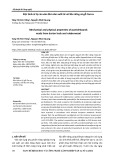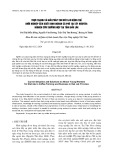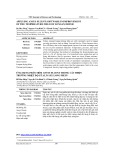
50 Nong Lam University, Ho Chi Minh City
The Journal of Agriculture and Development 23(6) www.jad.hcmuaf.edu.vn
Aerogel materials from sugarcane bagasse: the effect of additives
Van T. T. Le*, Ty H. Nguyen, Chien M. D. Vu, & Phuong T. Nguyen
Faculty of Chemical Engineering and Food Technology, Nong Lam University, Ho Chi Minh City, Vietnam
ARTICLE INFO ABSTRACT
Research Paper
Received: December 21, 2023
Revised: January 18, 2024
Accepted: January 31, 2024
Keywords
Agricultural waste
Biomass
Cellulose Aerogel
Sugarcane bagasse
*Corresponding author
Le Thi Thanh Van
Email:
thvan@hcmuaf.edu.vn
Cellulose nano fibers (CNF) are being considered as potential
material for producing aerogel, an advanced materials for filtration
technology. In this study, CNF were extracted from the sugarcance
bagasse (a common agricultural waste) using ultrasonic
technology and then fabricated with different additives including
polyvinyl alcohol (PVA), polyethylene glycol (PEG) and graphene
oxide (GO) to formulate aerogels. Various advanced techniques
including polarized and scanning electron microscopy, fourier
transform infrared spectroscopy (FTIR) and texture analyzer
were applied to elaborate on the physicochsemical properties of
the products. The obtained results revealed that aerogel had low
bulk density (0.032 kg/m
3
; 0.035 kg/m
3
& 0.041 kg/m
3
) and a high
porosity (96.89%; 97.06% & 98.61%) when combined with PVA,
PEG and GO, respectively. Among investigated samples, aerogel
fabricated with GO had the highest mechanical resistance as well
as the best elasticity.
Cited as: Le, V. T. T., Nguyen, T. H., Vu, C. M. D., & Nguyen, P. T. (2024). Aerogel materials from
sugarcane bagasse: the effect of additives. The Journal of Agriculture and Development 23(6), 50-56.
1. Introduction
Sugarcane is a common agricultural product
of most tropical countries. While this plant plays
an important role in improving the income of
famer, the sugar industry also releases a high
amount of sugarcane bagasse (approximately
30% of raw material). According to research
many studies (Somerville et al., 2010; Mahmud
et al., 2021), this waste currently creates pressure
on landfills and pollution on incineration.
Although sugarcane bagasse could be utilized
for bioconversion purposes, such as bioethanol,
xylitol, and specialty enzymes but these
approaches still have not yet been widely applied
due to the limit of technology and economics
constraints (Chandel et al., 2012).
Indeed, sugarcane bagasse is a fibrous material
containing cellulose as its main component
and therefore, it is a potential raw material for
producing aerogels. These advanced gels are

Nong Lam University, Ho Chi Minh City 51
The Journal of Agriculture and Development 23(6) www.jad.hcmuaf.edu.vn
size range of 0.25 mm were reacted with NaOH
solution (3% wt) with a ratio of 1:5 at 90oC for
3 h to break lignocellulosic linkages. Then, the
sample was bleached by H2O2 (10% wt) with a
ratio 1:5 at 60oC for 10 h. The mixture was rinsed
with distilled water to neutral pH and dried at
70oC for 24 h to obtain cellulose fibers. These
fibers, then, were grinded finely and soaked into
distilled water at 80oC for 1 h before ultrasound
dispersing for 15 min to obtain the CNF
suspension. CNF was refrigerated at 4oC for use
in later experiments.
2.3. Preparation of graphene oxide (GO)
Graphene oxide was prepared according to
the modified Hummer’s method (Li et al., 2019).
Firstly, the mixture including graphite (2 g),
NaNO3 (1 g) and KMnO4 (6 g) was slowly added
into H2SO4 (98% wt). Reaction was conducted
at 5°C for 90 min and hold at 40oC for 30
following minutes. Then, 92 mL of deionized
water was added dropwise to the solution, and
the temperature of the reaction was maintained
at 95oC until the color of mixture turns from
dark green to light brown. H2O2 (30% wt) was
added to the reaction mixture until no more
visible bubbles were produced, and the mixture
was allowed to stand. The solution was filtered
with HCl (2% wt) to completely remove the
remaining Mn ions. After adjusting to pH of 5 - 6
(using distilled water), the solution was dried at
70oC for 24 h to obtain GO.
2.4. Preparation of CNF/PVA & CNF/PEG &
CNF/GO
The PVA and PEG solutions (1.5% wt)
were prepared by dissolving these polymers
in deionized water at 75°C for 12 h. Hydrogels
were formed by mixing CNF suspension (2.5%
wt) with PVA/PEG/GO solution (1.5% wt) and
then ultrasound homogenizing the mixture for
15 min. Aerogels were formed by freeze-drying
hydrogels for 72 h using a laboratory lyophilizer
(BK-FD10S, Biobase, China).
an outstanding class of porous materials, with
an extremely low bulk density, and very high
porosity, and a low thermal conductivity (Nguyen
et al., 2021). Aerogels are being considered as the
most potential material for water treatment and
desalination. Cellulose based-waste materials
including sugarcane bagasse are ideal sources for
developing aerogels due to their renewable, and
biodegradable properties incineration (Thai et al.,
2020). Our study, therefore, aimed to transform
sugarcane bagasse into cellulose nano fibers
(CNF) and applied them for producing aerogels.
Besides, various additives including polyvinyl
alcohol (PVA), polyethylene glycol (PEG) and
graphene oxide (GO) was fabricated with CNF
to strengthen the structure of the aerogels.
2. Materials and Methods
2.1. Materials
Sugarcane bagasse was collected from
sugarcane juice carts. Chemical substances
including polyvinyl alcohol (PVA), polyethylene
glycol (PEG), sulfuric acid (H2SO4), hydrochloric
acid (HCl), hydrogen peroxide (H2O2), sodium
hydroxide (NaOH), graphite powder (94%),
sodium nitrate (NaNO3) and potassium
permanganate (KMnO4) were provided by
Xilong Scientific (China). All chemical subtances
were in the analytical grade.
2.2. Preparation of cellulose nanofibers (CNF)
Cellulose nanofibers were prepared based on
the combination of ultrasound homogenization
with chemical pretreatments (Chen et al., 2011b;
Xu et al., 2017). Briefly, raw materials were cut
into 1 - 2 cm pieces and washed several times
with water to remove impurities. Then, the
sugarcane fibers were dried in a laboratory oven
(Memmert, Germany) at 90oC for 72 h to the
moisture content of 65% and finely ground into
powder. The size of dried powder was controlled
using a laboratory shaking sieve (BK-TS200,
Biobase, China). Sugarcane fiber powders with a

52 Nong Lam University, Ho Chi Minh City
The Journal of Agriculture and Development 23(6) www.jad.hcmuaf.edu.vn
UK) equipped with a cylinder geometry (diameter
of 40 mm). The strain deformations of TPA and
SR methods were 50 and 10%, respectively while
the relaxation time was 300 sec.
The morphology of aerogels was observed
using a polarized light microscope (DM2500P,
Leica, Germany) and a scanning electron
microscope (JSM-IT500, Japan). Fourier
Transform Infrared (FTIR) spectroscopy of
samples was performed in the range of 400 - 4000
cm, with a 4 cm resolution at room temperature
(Tenser 27, Bruker, Germany).
2.5. Physicochemical properties characterization
of sugarcane bagasse aerogels
The density (ρ) and porosity (P%) of aerogels
were determined based on their dimensions
(20 x 40 mm) and weight. The specific surface
area of the aerogel was determined through
the N2 adsorption–desorption isotherm using
the Brunauer–Emmett–Teller (BET) method.
Besides, mechanical properties of products were
determined based on texture profile analysis
(TPA) and stress relaxation (SR) methods using a
texture analyzer (TA.XT Plus, Stablemicrosystem,
3. Results and Discussion
3.1. Morphology and microstructure of sugarcane bagasse aerogels
Figure 1. Morphology and microstructure of aerogels observed by naked eye (a, d, and g), polarized
light microscopy (b, e, and h) and scanning electron microscope (c, f and i). CNF: cellulose nano
fibers; PVA: polyvinyl alcohol; PEG: polyethylene glycol; GO: graphene oxide.

Nong Lam University, Ho Chi Minh City 53
The Journal of Agriculture and Development 23(6) www.jad.hcmuaf.edu.vn
a better homogenous crystal network for aerogel
as well as a lower surface area (12.97 and 2.70
m2/g for CNF/PVA and CNF/PEG, respectively).
However, the difference of porosity degree
between these samples was not significant. For
sample fabricated with GO (Figure 1i), a more
highly ordered structure was observed. Instead
of the heterogenous aggregation of CNF, GO
nanosheets tended to parallel arrange during the
drying and therefore helped to orientate the CNF
in the gel structure (Nguyen et al., 2021). Besides,
the fabrication of GO on sugarcane bagasse CNF
also significantly increased the density of aerogel
(P < 0.05) in compared with samples adding PVA
or PEG (Table 1).
The effect of additives on the morphologies
and microstructure of aerogels was displayed
in Figure 1 while their physical properties were
summarized in Table 1. As expected, polarized
light microscope (PLM) and scanning electron
microscope (SEM) observations revealed that
polymer fibers from sugarcane baggage were
CNF with a diameter in a range of 50 - 500 nm.
Similar to the findings from previous studies
(Chen et al., 2011a, 2011b & 2011c), sugarcane
bagasse-based aerogels also had a characteristic
porous structure (with a pore size diameter
of 10 - 50 µm) and a high porosity degree (97
- 98%). In comparison between PVA and PEG
(Figure 1c & 1f), the latter showed a better
compatibility with cellulose particles resulting in
Table 1. The density and porosity of sugarcane bagasse aerogels with different additives1
Sample Density
(g/cm3) Porosity (%)
CNF/PVA 0.032 ± 0.003a96.89 ± 0.002a
CNF/PEG 0.035 ± 0.005a97.06 ± 0.001a
CNF/GO 0.041 ± 0.002b98.61 ± 0.001a
1Data expressed as mean ± standard deviation (n = 3).
a,bValues within the same column having different letters are significantly different (P < 0.05) between means
of samplesd.
CNF: cellulose nano fibers; PVA: polyvinyl alcohol; PEG: polyethylene glycol; GO: graphene oxide.
3.2. FTIR
Figure 2. Fourier transform infrared spectroscopy spectra of sugarcane bagasse aerogels with
different additives. PVA: polyvinyl alcohol; PEG: polyethylene glycol; GO: graphene oxide.

54 Nong Lam University, Ho Chi Minh City
The Journal of Agriculture and Development 23(6) www.jad.hcmuaf.edu.vn
1010 cm characterizing for the presence of C=O
and C-O-H bonds of their backbone (Dao et al.,
2022) while other peaks at 3300, 2900 and 1000
cm were contributed by O-H, C-H and C-H2
linkages of glucose units. Besides, the addition
of PVA and GO seem not to affect the chemical
properties of CNF. For sample added PEG, some
extra adsorption peaks were recognized at 1452
cm and 1245 cm. They should be associated with
the bending and stretching vibrations of C-H
and C-O groups, respectively (Sahu et al., 2022).
To elaborate further the effect of additive
on sugarcane bagasse-based aerogels, FTIR
spectroscopy was used to analyze functional
groups of samples and the results was depicted on
Figure 2. As hypothesized, lignin lignocellulose
fibers have been significantly removed after
alkaline treatment and bleaching step. Therefore,
their characterized peak at 1730 cm was not
recognized in the FTIR spectrum of investigated
aerogels (Thai et al., 2020). For CNF, strong
adsorption peaks were observed at 1606 cm and
3.3. Mechanical properties of aerogels
Table 2. Mechanical properties of sugarcane bagasse aerogels with different additives1
Texture profile analysis Stress relaxation (SR)
Sample Hardness (N) Cohesiveness Firmness (N) SR (%)
CNF/GO 55,593 ± 1,15a0,942 ± 0,001a31,096 ± 2,93a40,08a
CNF/PVA 48,86 ± 1,296a0,877 ± 0,012b28,75 ± 0,8a45,51a
CNF/PEG 27,261 ± 1,098c0,775 ± 0,015c18,22 ± 0.11b65,65b
1Data expressed as mean ± standard deviation (n = 3).
a-cValues within the same column having different letters are significantly different (P < 0.05) between means
of samples.
CNF: cellulose nano fibers; PVA: polyvinyl alcohol; PEG: polyethylene glycol; GO: graphene oxide.
The mechanical properties of aerogels play
an important role for their applications as well
as their shelf-life. Two different testing methods
including TPA and SR were applied to compare
the texture properties between samples and
the results were summarized in Figure 3 and
Table 2. As expected, aerogels adding GO had
a highest hardness and mechanical resistance.
The presence of GO particles contributed to
improving the strength for the crystal network
of sugarcane bagasse-based aerogel (Figure 1i).
In line with the findings from FTIR analysis,
mechanical parameters between CNF/PVA and
CNF/GO aerogels had a high similarity, and the
difference was mainly recognized for CNF/PEG
sample. The hardness and firmness of the latter
was approximately 40% of CNF/GO aerogel. All
samples showed a well recovery property with a
high cohesiveness (0.8 - 0.9) but their SR degrees
showed a significant difference. While CNF/PVA
and CNF/GO aerogels showed a well balance
between the elastic and viscous components
(SR in a range of 40 - 50), the addition of PEG
to aerogels significantly increased the loss
modulus of sample. It could be assumed that the
presence of hydrophilic groups in PEG affected
the linkages between hydrophobic groups of
polymers in CNF aerogels.





![Tài liệu kỹ thuật tái canh cây cà phê [chuẩn nhất]](https://cdn.tailieu.vn/images/document/thumbnail/2025/20250909/kimphuong1001/135x160/5411757389201.jpg)




















